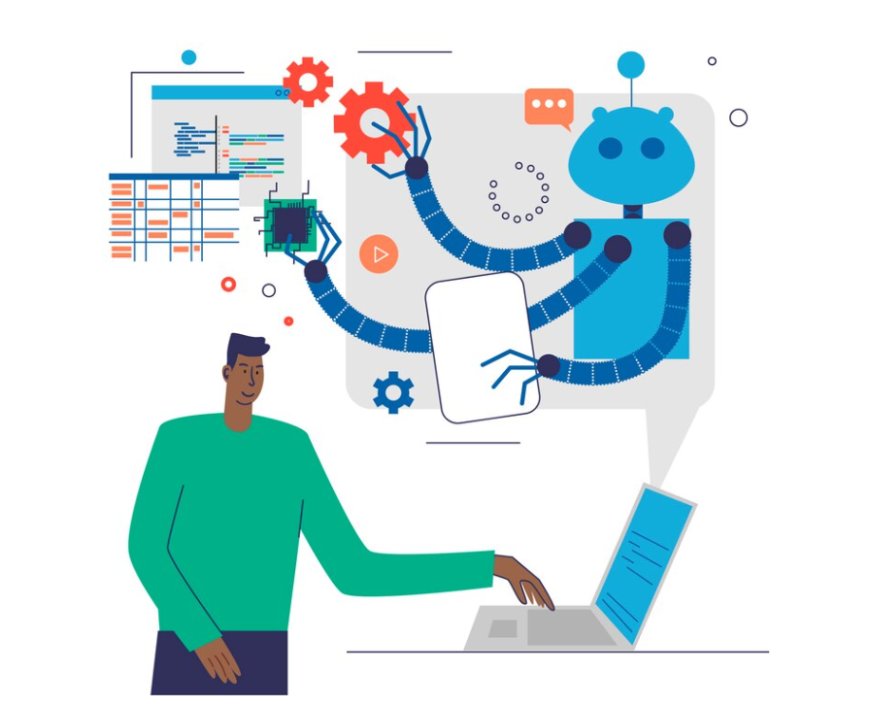AI-Powered Data Analytics: Where Machine Learning Meets Big Data
Delve into the dynamic realm where machine learning intersects with big data in AI-powered data analytics. Explore the synergy of advanced algorithms and large datasets, unlocking unprecedented insights for businesses and industries.

In the rapidly evolving landscape of data-driven decision-making, the convergence of Artificial Intelligence (AI) and Big Data has emerged as a transformative force, giving rise to AI-Powered Data Analytics. This intersection marks the seamless integration of advanced machine learning techniques with the vast and complex datasets characteristic of the Big Data paradigm. In this synergy, machine learning algorithms navigate through massive datasets, extracting valuable insights, patterns, and predictions at a scale and speed previously unimaginable. This synergy not only enhances traditional analytics capabilities but also opens new frontiers in predictive modeling, personalized experiences, and real-time decision-making.
Foundations of Machine Learning in Data Analytics
The foundations of machine learning in data analytics form the bedrock upon which modern data-driven decision-making processes are built. Machine learning, a subset of artificial intelligence, empowers systems to learn and improve from experience without explicit programming. In the context of data analytics, machine learning algorithms play a pivotal role in extracting meaningful insights, patterns, and predictions from vast datasets.
Within machine learning, various types of algorithms are employed. Supervised learning involves training a model on a labeled dataset, where the algorithm learns to map input data to corresponding output labels. Unsupervised learning, on the other hand, deals with unlabeled data, seeking to identify hidden patterns or groupings within the dataset. Reinforcement learning introduces an element of decision-making, where an algorithm learns to make sequential decisions by interacting with its environment.
Feature engineering is another critical aspect of the foundations of machine learning in data analytics. It involves selecting and transforming relevant features (variables) from the dataset to enhance the performance of machine learning models. The quality of features directly influences the model's ability to discern meaningful patterns and make accurate predictions.
The Big Data Challenge
The Big Data Challenge encompasses the complexities associated with handling and extracting meaningful insights from vast and diverse datasets that exceed the capabilities of traditional data processing methods. Big data is characterized by the three Vs—Volume, Velocity, and Variety—representing the sheer scale of information, the speed at which it is generated, and the diverse formats it can take. Unlike conventional data analytics, which may be performed on smaller datasets using traditional databases, big data analytics requires specialized tools and frameworks capable of processing and analyzing massive amounts of information.
Traditional analytics tools often fall short when confronted with the sheer volume of data generated in today's digital age. The size of datasets has grown exponentially, encompassing everything from social media interactions and sensor data to transaction records and beyond. As a result, the challenge lies not only in storing and managing this massive volume of data but also in deriving meaningful insights and patterns from it.
Moreover, big data analytics introduces the element of velocity, emphasizing the need for real-time or near-real-time processing. This is particularly crucial in applications such as fraud detection, where timely analysis of streaming data can make the difference between preventing and responding to fraudulent activities. To meet this challenge, new technologies and frameworks, such as Apache Spark, have emerged to enable parallel processing and distributed computing, allowing for the swift analysis of large datasets.
Convergence of Machine Learning and Big Data
The convergence of machine learning and big data represents a significant milestone in the field of data analytics. This phenomenon occurs when the vast amounts of data collected by organizations, often termed "big data," are combined with the power of machine learning algorithms to extract valuable insights, patterns, and predictions. Here are some key aspects of this convergence:
Integration of Machine Learning Algorithms: Machine learning algorithms have proven to be highly effective in tasks such as classification, regression, and clustering. When integrated into big data frameworks, these algorithms can process, analyze, and extract meaningful information from massive datasets that would be impractical or impossible to analyze using traditional methods. This integration allows organizations to unlock the hidden potential of their data.
Handling Large Datasets: Big data is characterized by its volume, velocity, and variety. Machine learning techniques have evolved to cope with the challenges posed by these large and complex datasets. Distributed computing platforms like Apache Hadoop and Apache Spark enable the parallel processing of data, making it feasible to train machine learning models on data distributed across multiple servers or clusters.
Real-Time Processing and Analytics: Another crucial aspect of this convergence is the ability to perform real-time data processing and analytics. Machine learning models can be deployed in streaming data environments to make instant predictions or identify anomalies as new data arrives. This is particularly valuable in applications like fraud detection, where timely decisions are critical.
Iterative Learning: Machine learning algorithms are often iterative, refining their models with each new piece of data they encounter. In big data environments, this iterative learning can continuously improve the accuracy and relevance of models over time, allowing organizations to adapt to changing trends and patterns.
Scalability: Big data technologies provide the scalability needed to handle the ever-increasing size of datasets. As data continues to grow, the convergence of machine learning and big data ensures that organizations can keep up with this growth and make data-driven decisions effectively.
Tools and Technologies
In the realm of AI-powered data analytics, the choice of tools and technologies plays a pivotal role in determining the efficiency and success of analytical processes. A diverse set of tools is employed to seamlessly integrate machine learning with big data, catering to the intricate requirements of processing and analyzing vast datasets. Leading the charge are powerful machine learning frameworks such as TensorFlow and PyTorch, which provide a robust foundation for developing and deploying advanced models. These frameworks facilitate the training of models on large datasets, enabling businesses to extract valuable insights from the ever-expanding sea of information.
Complementing the machine learning aspect are big data processing frameworks like Apache Hadoop and Apache Spark. These frameworks excel in handling the massive volumes of data characteristic of big data environments. They leverage distributed computing to break down complex tasks into smaller, more manageable processes, ensuring scalability and efficient data processing. Cloud platforms further enhance the agility and scalability of AI-powered data analytics by providing flexible and cost-effective solutions for storage, computation, and deployment.
As organizations increasingly shift towards cloud-based infrastructures, tools that seamlessly integrate both machine learning and big data processing become indispensable. Cloud platforms, such as AWS, Azure, and Google Cloud, offer a suite of services that enable businesses to build end-to-end data analytics pipelines. These platforms provide the necessary resources and infrastructure for training machine learning models at scale, running analytics on vast datasets, and deploying models into production environments.
Challenges and Ethical Considerations
Challenges and Ethical Considerations in AI-powered data Analytics represent critical aspects that demand careful attention in the rapidly evolving landscape of technology and information processing. The proliferation of machine learning in data analytics introduces challenges such as ensuring data privacy and security, as vast datasets become valuable targets for unauthorized access. Moreover, the potential for bias in machine learning models raises ethical concerns, particularly in decision-making processes that impact individuals or communities.
Transparency and interpretability of these models are crucial to building trust and understanding, as complex algorithms can sometimes operate as "black boxes." Addressing these challenges requires a multi-faceted approach, involving not only technological advancements but also the development and enforcement of robust ethical frameworks. Striking a balance between innovation and ethical considerations is pivotal to harnessing the full potential of AI-powered data analytics responsibly.
Future Trends
AI in Edge Computing: AI will be increasingly deployed at the edge (e.g., IoT devices) for real-time data analysis and decision-making, reducing latency and enhancing efficiency.
Explainable AI (XAI): Emphasis on developing AI models that are more interpretable and transparent, addressing concerns about the "black box" nature of some algorithms.
AI for Natural Language Processing (NLP): Advancements in AI-driven NLP will lead to improved chatbots, virtual assistants, and automated language translation services.
Federated Learning: Increasing adoption of federated learning, allowing models to be trained across multiple decentralized devices without transferring sensitive data to a central server.
Quantum Computing: The potential integration of quantum computing for more complex AI and data analytics tasks that were previously infeasible for classical computers.
AI-Generated Content: A rise in AI-generated content, including art, music, and even news articles, with implications for copyright and authenticity.
AI for Healthcare: Further integration of AI in healthcare for diagnosis, treatment recommendations, drug discovery, and patient management.
Responsible AI: A focus on ethical AI development, including regulations, standards, and guidelines to ensure fairness, accountability, and transparency in AI systems.
The fusion of AI-powered data analytics with big data represents a monumental stride in our capacity to glean actionable insights from massive and complex datasets. As machine learning algorithms continue to evolve and big data technologies advance, this synergy will unlock new opportunities for businesses, healthcare, and society at large. However, it also poses ethical challenges and demands a commitment to transparency, fairness, and security. The future holds tremendous promise for AI-powered data analytics, and organizations must embrace this powerful partnership to stay competitive and make data-driven decisions that can shape a better, data-rich world.











































